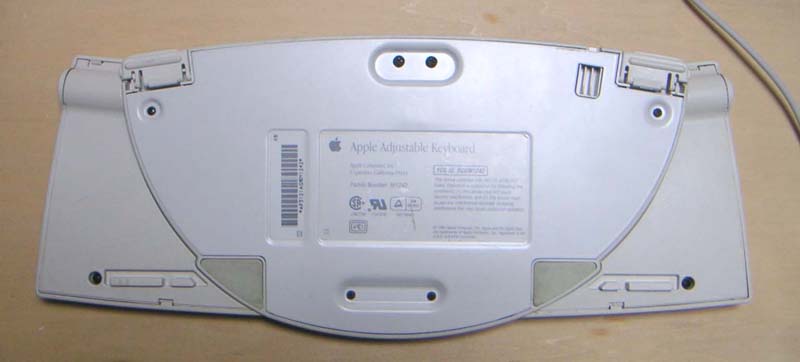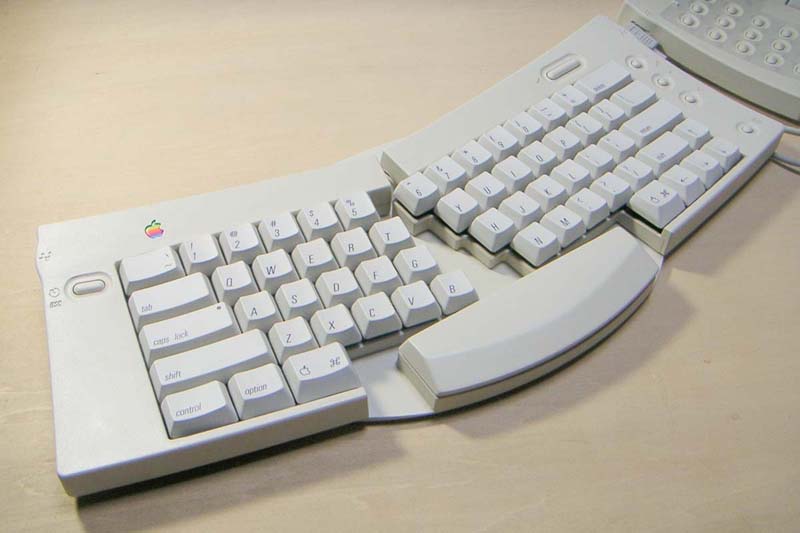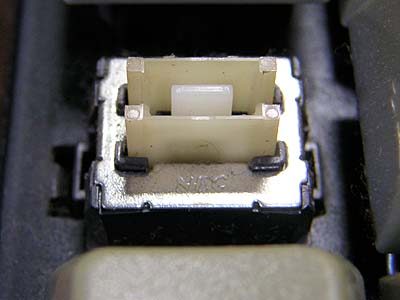 |
 |
 |
|
|
 |

|
Please note that a metal
spring is used to lock
legs in up-right position. |
I don't have any Mac system and do
not know
how to use these tact
switches..
|
|
|
|
ALPS Low Profile Switch
Switches used in this board is described as SKFS/clicky in ALPS catalog
'94 edition.
But mine doesn't click at all but gives firm tactile feedbacks.
In
famous MouseFan page, the author says his adjustable
has clicky
sound.
By what reason, mine had
been lubricated with oily grease all around stems, inside
switching assemblies including click( tactile )
leaves. Because I didn't know if mine had been
initially lubricated by factory or ex-owner had done it, I didn't
want to make this Adjustable page for long. But it's not
that bad to examine ALPS Low Profile Switch.
U.S Patent 4935591 is very close to this switch. but Figs in
this patent paper are bit different from this switch.
You can see
patent 4935591
here
Here is mine.
|
 |

|
|
You may notice grease pasted around
stems. |
Close up of a stem
|
|
|
 |
|
not a little bit of grease, but a lot of
grease used around a stem, click leaf, coiled spring and inner
walls of upper housing.
You can use a hand made Cherry MX tool for disassembling upper
housing of this Low Profile Switch.
|
| Inner construction and parts |
 |
A cupper belt seen in upper section is a built-in jumper.
Bellow the jumper, you can see a click leaf ( tactile leaf
in this case) |
 |
Viewing from opposite angle.
Switching assembly is similar with what can be seen in U.S
patent
4935591 as noted above.
|
 |
Some may feel this switching construction resembles those used
in Simplified-I.
But there are big differences between this one and
simplified-I.
1. Movable switching leaf with two arms is placed close to a
wall
( outer side ) and non-movable plate
is placed close to a stem.
2. Both leaf and plate are tightly held within slits in a lower
base assembly.
Those switching plates in Simplified-I are just
loosely sit in a
base assembly and are kept upright position in
separated
rooms in upper housing. For easy assembling of
a switch, there
are excessive space in an upper housing for
switching plates.
|
 |
 |
This side meets a Click( tactile ) leaf.
|
This side meets a switching leaf. Two projections at both
side
push switching leaf and open contacts at up most position of
a stem.
|
 |
 |
Click leaf.
The bumps at the both end make clicking sound.
I think upper portion of arms at both ends hit a jumper
too.
|
This side faces to a stem.
You can see two stabilizing bends in about 80 degrees at the
bottom den of the plate. |
|
|
 |
 |
|
Upper housing from top
|
Upper housing; inner view
|
Is this board clicky or
tactile ?
After removing oily grease from a stem, leaf spring, inner walls
around a jumper plate in the lower housing, this switch actually
generate slicking sound. But it's impossible to remove all
grease from inner assemblies. removing/assembling click leaf is
tad difficult compared to real-complicated Bigfoot class
ALPS. I don't want to do this cleaning for all
switches on this board. Apple used tactile alps switches for their mechanical keyboards
like M0115, M0116, GS-II board and extended II with rubber
damper. In order to produce this board with complicated
adjustable mechanism, Apple might use ALPS Low Profile switch in order
to save total height of this keyboard. While in ALPS low profile line, ALPS had only two variations, one
was clicky ( model number SKFS ) and the other was linear (
model number SKFR )*1. For this board,
Apple chose clicky
version by what reason。Mine might be modified with grease by
ex-owner to decrease cliking
sound.
|
 |
|
Looks COOL! want a NIB one with palm
rests. |
|
By the way........ |
 |
 |
|
Don't you think this NEC switch looks like
to ALPS Low Profile ? You can see this
switch here
|





















